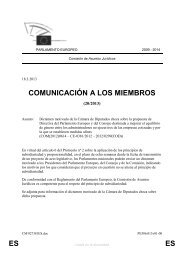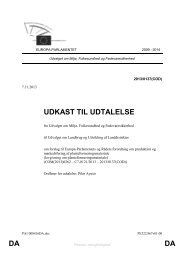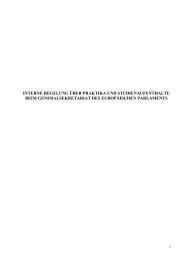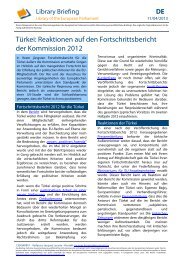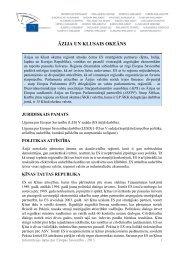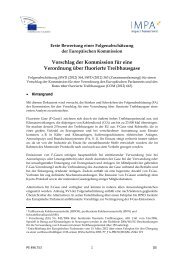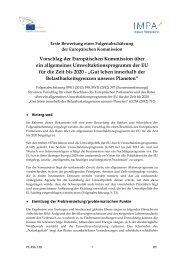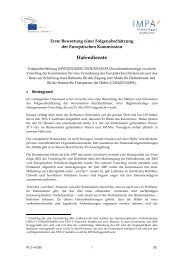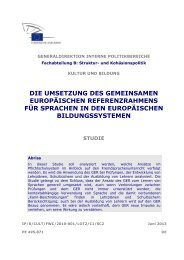Link to the study - European Parliament - Europa
Link to the study - European Parliament - Europa
Link to the study - European Parliament - Europa
Create successful ePaper yourself
Turn your PDF publications into a flip-book with our unique Google optimized e-Paper software.
Policy Department D: Budgetary Affairs<br />
____________________________________________________________________________________________<br />
During decommissioning <strong>the</strong> so accumulated raw wastes have <strong>to</strong> be treated, packaged and later<br />
disposed. Depending from <strong>the</strong> material several treatment methods are applicable:<br />
Drying (for liquid or wet waste);<br />
Compaction or super-compaction (for resins, filters, metal scrap or o<strong>the</strong>r materials);<br />
Cutting (for metals);<br />
Cementation (for metals);<br />
Incineration (for combustible wastes).<br />
For a brief overview on widely applied treatment methods (see WNA 2013). Treatment goals are:<br />
volume reduction, limiting chemical gas generation, reducing microbial activity associated with gas<br />
generation, immobilization (avoiding of losses of contaminated liquids or release of contaminated<br />
dust particles) and inner-package corrosion prevention (e.g. drying).<br />
Those technical methods are simple and robust. However, incompatibilities between <strong>the</strong> waste and a<br />
potential matrix have <strong>to</strong> be avoided, e.g. cementation of evaporation wastes, resins or incineration<br />
ashes due <strong>to</strong> chemical reactions of concrete with <strong>the</strong>se materials.<br />
Characteristics of plasma technology<br />
A very special technology, ra<strong>the</strong>r expensive and very rarely applied is <strong>to</strong> heat <strong>the</strong> wastes in a plasma<br />
oven <strong>to</strong> extremely high temperatures of several 1 000 C, so that carbon and organics are destroyed<br />
and released as CO2. Metals are molten <strong>to</strong> yield metal and slag. The method was applied for<br />
combustible conventional wastes, e.g. at Karlsruhe/Germany ('Thermoselect/Sinerga') with a typically<br />
high energy input (electricity), high specific operating costs and technical difficulties, so that <strong>the</strong><br />
operation of <strong>the</strong> mentioned facility has been s<strong>to</strong>pped by <strong>the</strong> opera<strong>to</strong>r. A facility for treating<br />
operational LLW nuclear wastes at Würenlingen/Switzerland required enormous technical backfitting<br />
<strong>to</strong> achieve <strong>the</strong> designed throughput. A pilot plant in <strong>the</strong> nuclear research center in Mol/Belgium was<br />
operated in <strong>the</strong> 1980ies without positive results.<br />
With nuclear wastes <strong>the</strong> high temperature of <strong>the</strong> plasma oven evaporates a considerable number of<br />
radionuclides that are common constituents in operational wastes, such as Tritium (H-3, mainly as<br />
tritiated water), Cesium-137 and Carbon-14. To limit doses received in <strong>the</strong> vicinity of <strong>the</strong> facility <strong>the</strong><br />
off-gas has <strong>to</strong> be cooled down and filtered (e.g. for Cesium-137). C-14 cannot be filtered without<br />
enormous additional efforts (as it requires <strong>the</strong> removal of <strong>the</strong> complete carbon dioxide from <strong>the</strong><br />
discharged gas stream and its later disposal as radioactive waste) and so generating large quantities<br />
of secondary wastes. Emitted C-14 dominates <strong>the</strong> doses in <strong>the</strong> vicinity of such plants by far and, due<br />
<strong>to</strong> its long half-life time and its high mobility, circulates in <strong>the</strong> environment ('carbon cycle') and causes<br />
high collective doses. The condensate from <strong>the</strong> off-gas cooling stage concentrates all evaporated<br />
tritiated water and can have considerably higher concentrations (requiring additional treatment of<br />
<strong>the</strong> condensate if it exceeds release criteria) (Nachtrodt 2013).<br />
126




